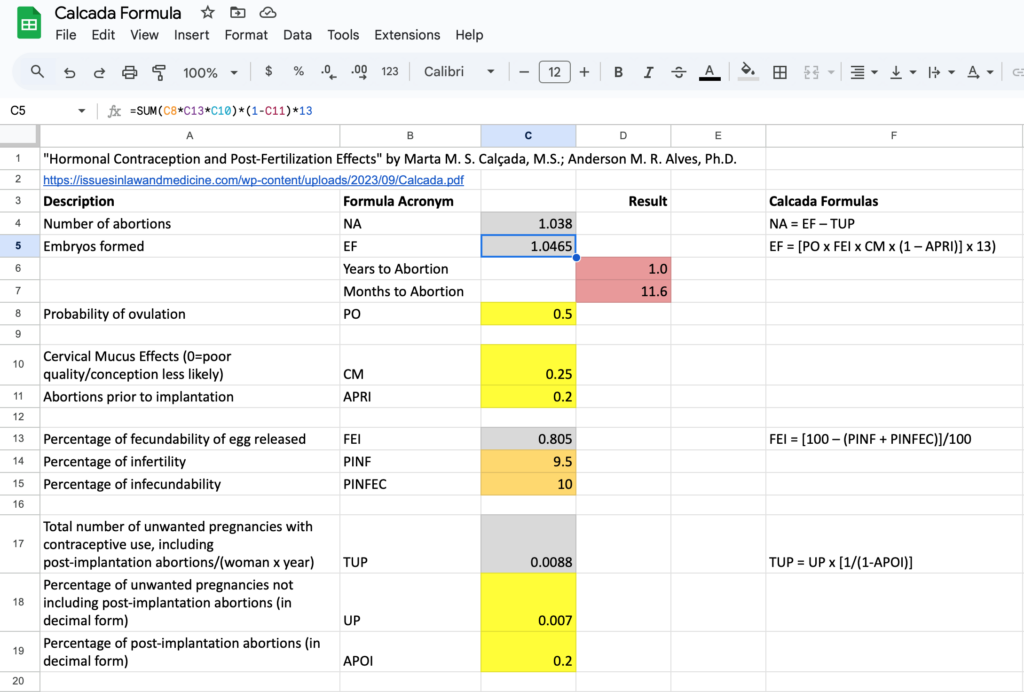Calculating the Probability of Abortion on HC Using Research Data
“If Christianity were true, would you become a Christian?”
Christian apologist Frank Turek often asks this question to non-Christians.
Surprisingly, sometimes the answer is no.
When someone irrationally says “no,” it indicates that their reservations about becoming a Christian are not actually from the head, but from the heart.
For some, even if all their questions are answered, even there is compelling evidence, even if something is clearly true, the thought of changing the way they live to reflect this truth is too much. And so they don’t.
Controversy and concern about hormonal contraception (HC) working as an abortifacient has been ongoing for decades. Pro-life Protestants want to know:
- Is HC causing abortions?
- Is so, how often might it be happening?
If it were true that hormonal contraception was causing abortions, would you speak out against it?
I think many Protestants would answer, “Yes.”
Marta M. S. Calçada, and Anderson M. R. Alves have calculated the probability of abortion in their 2022 paper “Hormonal Contraceptives and Post-fertilization Effects” published in Issues in Law and Medicine.1
These authors took data from research papers and developed a formula to calculate the probability of abortion based on different types of hormonal contraception. They accounted for factors such as:
- Percentage of ovulation events despite contraceptive use/(woman x year)
- Percentage of fecundability of egg released
- Cervical mucus effect
- Percentage of pre-implantation abortions, independent of contraceptive
use - Percentage of infertility
- Percentage of infecundability in ideal conditions of non-sterility nor
physiological problem, maintaining several relationships in the most fertile phase of the woman’s cycle (proximity to the LH peak); - Total number of unwanted pregnancies with contraceptive use, including
post-implantation abortions/(woman x year) - Percentage of unwanted pregnancies not including post-implantation abortions
- Percentage of post-implantation abortions
And the results might surprise you.

Table 6 from Calcada and Alves, “Hormonal Contraception and Post-Fertilization Effects”
The table above suggests that using the mini-pill (“POC oral” in the table), based on the calculated probabilities, likely leads to an abortion in 1 year.
More specific results of the mini-pill calculations are provided in Table 2 from the paper.

Rolling the Dice
If there is 1 abortion in one year and 13 possible cycles (based on a 28-day menstrual cycle), then each cycle there is a 1 in 13 chance of abortion.
That’s like rolling a 13-sided die (tridecahedron) every menstrual cycle, and every time you roll a 13, an abortion occurs.
Try rolling a 13 sided die here.
On which roll did you roll a 13? The second? The sixth? The thirteenth? Maybe you rolled a 13 multiple times. That’s how probabilities work. An abortion could occur in the second month of use or the ninth or the sixteenth. But the statistical average over time is 13 rolls to an abortion using progesterone only contraceptives.
This is not good news for progesterone-only contraceptives intended to be used for many years at a time.
Want to play with the numbers? I’ve re-created the Calcada formula that you can access here.

Screenshot of publicly available Google Sheet re-creating the Calcada formula. Screenshot numbers represent the progesterone only contraceptive case assuming a 50% probability of ovulation and 7% unwanted pregnancy rate.
Change the percentage of ovulation based on the hormonal method and see what happens.
Change the percentage of unwanted pregnancies based on effectiveness rates and see what happens.
One thing that stands out from the paper is the time to abortion for the combined-oral-contraceptive pill for typical use (58 years) and perfect use (10 years) using an estimated ovulation rate of 5%.
(Abortion takes longer with typical use because the pregnancy rate is higher leading to less cycles available for abortion)
The formula shows that extremely low ovulation rates make contraceptives more effective. This should be fairly obvious.
The problem with hormonal contraceptives that theoretically prevent the most ovulation (COCs) is that they have also had the most known health effect risks. That’s why many women swith to the mini-pill (POP).
But POPs have higher ovulation rates, and as you have already seen from the formulas, POPs with a 50% ovulation rate decrease the time to abortion from 58 years to 1 year.
Is a 1 in 13 chance of something bad happening every month enough to persuade you from changing a behavior? Would it matter if it were 1 in 3? One in 5,000?
That’s up to you. But there are numbers to help guide the discussion.
One of the demands of contraception agnostics is data.
Here it is.
The formula is sound. The data is from various research papers from various publishers.
Can you put away your priors and look at the numbers?
By the numbers, this looks like pretty good evidence that HC is causing abortions, and maybe more frequently that you thought.
Based on these probabilities, it seems true that HC is causing abortions.
Is this enough for Protestants to speak out against it?
- Calçada, M. M. S., & Alves, A. M. R. (2022). Hormonal Contraceptives and Post-fertilization Effects. Issues in law & medicine, 37(1), 29–80. https://issuesinlawandmedicine.com/wp-content/uploads/2023/09/Calcada.pdf ↩︎

